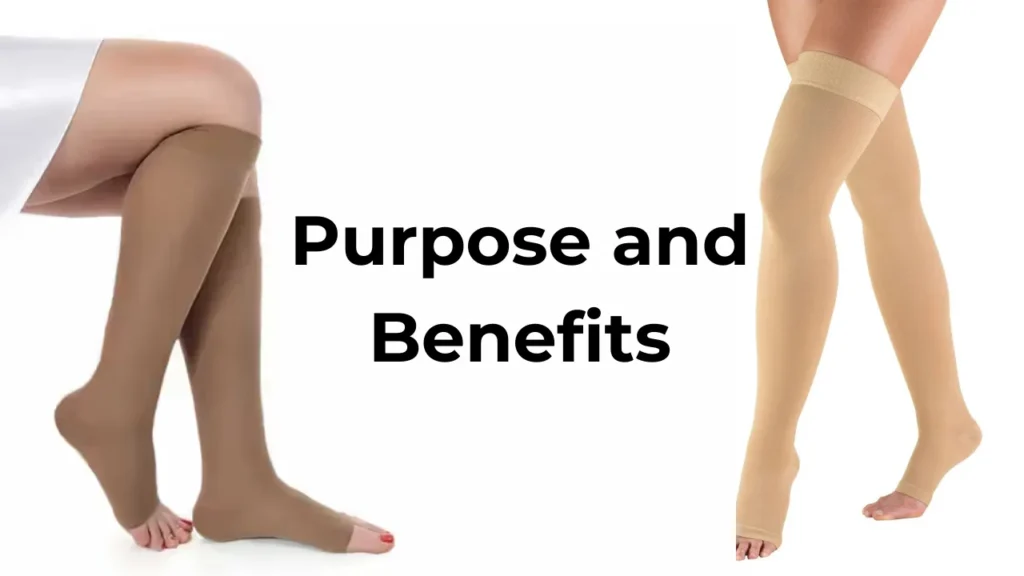Introduction
Specialized hosiery called Open Toe Compression Stockings applies graduated pressure to the legs to improve blood circulation and alleviate venous conditions. This style of stocking differs from the norm by leaving the toes exposed, which provides a number of advantages for a variety of medical and comfort concerns.
Purpose and Benefits

The principal role of compression stockings is to apply regulated pressure to the lower extremities, which helps with:Improved Blood Flow: By gradually tightening at the ankle and loosening further up the leg, the graduated compression allows blood to flow upwards, resisting the pull of gravity.
Edema in the lower extremities can be reduced with the use of these stockings because they keep fluid from pooling there.
They reduce the risk of blood clots, which can occur during long periods of immobility like flights or bed rest, thus preventing deep vein thrombosis (DVT).
When used on a regular basis, varicose and spider veins can be managed, and the pain and swelling that come with them can be significantly reduced.
The open-toe design is ideal for patients who need to check their toes often but don’t want to take off their stockings completely.
Wearing sandals or open-toe shoes while still getting the therapeutic benefits is a win-win.
If you live in a warmer climate, you may find that exposing your toes helps keep your feet cooler by allowing air to circulate more freely.
Indications for Use
After surgery, doctors typically advise patients to wear open-toe compression stockings to speed healing and reduce the risk of blood clots.
To alleviate symptoms and promote vein function in chronic venous insufficiency.
Lymphedema: To control edema in the limbs by making it easier for lymph fluid to drain.
During pregnancy: to ease swelling in the legs caused by an increase in blood volume and to alleviate leg discomfort.
Those whose jobs require them to stand or sit for long periods of time may benefit from this, as it helps keep their blood flowing.
Compression Level
The millimeters of mercury (mmHg) measurement is used to classify compression stockings:Gentle (8–15 mmHg): Apt for preventing fatigue and mild swelling.
Mild varicose veins and pregnancy discomfort can be alleviated with moderate pressure (15–20 mmHg).
Moderate edema, moderate varicose veins, and post-sclerotherapy are all managed with a firm (20-30 mmHg) pressure.
For cases of severe lymphedema and venous insufficiency, Extra Firm (30-40 mmHg) is prescribed.
For the best results and least risk, follow your doctor’s orders when making your selection.
Materials and Design Features
Nylon, spandex, and natural rubber latex are some of the materials used to make modern open-toe compression stockings. These stockings provide:Consistent compression over time is ensured by its elasticity and durability.
Optimal breathability for all-day comfort.
The ability to wick away moisture means less chance of infections and dry skin.
Socks come in a variety of styles to meet personal preference and medical needs, including knee-high, thigh-high, and pantyhose. Some have silicone bands to keep them from sliding, and others have zippers to make them even easier to put on.
Proper Usage and Care
In order to get the most out of compression stockings with open toes:Precise Measurement: To choose the right size, measure your leg length, calf width, and thigh height.
Wearing aids or gloves can make donning the stockings easier and safer.
Stick to the recommended wear time, which is usually during the day, to get the best results.
Stockings last longer and keep their elasticity with regular hand washing in mild soap and air drying.
Potential Considerations
The following considerations should be kept in mind by users: Skin Sensitivity: In cases where latex is present, it is extremely important to keep an eye out for any symptoms of irritation or allergic reactions.
Make Sure They Fit: Pain or reduced blood flow might result from stockings that don’t fit properly.
Warning: People who have certain medical conditions, like peripheral arterial disease, should talk to their doctors before using this product.
Choosing the Perfect Compression Stockings for Your Open Toes
To get the most out of your open-toe compression stockings and keep your feet comfortable, it’s important to choose the right ones. There are a number of things to think about:
Compression Levels
Millimeters of mercury (mmHg) is the standard unit of measurement for the pressure that compression stockings apply:For small swelling and to prevent fatigue, use mild compression (8-15 mmHg).
When dealing with mild varicose veins or pregnancy discomfort, moderate compression (15-20 mmHg) is the way to go.
Moderate edema, varicose veins, and post-sclerotherapy can be managed with firm compression (20-30 mmHg).
For cases of severe lymphedema and venous insufficiency, extra firm compression (30-40 mmHg) is prescribed.
In order to ascertain the suitable compression level according to specific medical requirements, it is crucial to consult with a healthcare professional.
Material and Fabric
Comfort and effectiveness are affected by the material choice:Combinations of Nylon and Spandex: Provide pliability and long-term support, guaranteeing uniform compression.
It’s breathable and great for people with sensitive skin.
The combination of microfiber’s suppleness and its ability to wick away sweat ensures that your skin stays dry.
The wearing experience can be improved by choosing a material that is compatible with one’s skin sensitivity and personal comfort preferences.
Size and Fit
The stockings won’t work properly unless you get the right size:Factors to Consider: Take precise measurements of the leg length, ankle circumference, and calf and thigh width.
To find the right size, look at the size charts provided by the manufacturer.
Make an appointment for a tailor to measure if you have unusual leg sizes, shapes, or medical issues.
Problems like slipping, bunching, or overly tight clothing can be avoided with a precise fit.
Which length is best depends on the patient’s unique medical needs as well as their level of comfort.
Care and Maintenance
The efficacy and longevity of compression stockings depend on regular maintenance:Wash by hand using gentle soap and water; do not use strong detergents.
To maintain pliability, let air dry away from strong sunshine.
Look for thinning or tears or other indications of wear on a regular basis and replace if needed.
If you take good care of your stockings, they will last longer and continue to provide therapeutic benefits.
Potential Side Effects and Precautions
There are a few things you should know before using open toe compression stockings, despite their benefits:
Skin Irritation
Itchy skin or allergic reactions can happen to some people:Redness, itching, or a rash on the parts of the body that the stockings cover is a possible symptom.
Wear hypoallergenic stockings and practice good personal hygiene.
Do not continue use until you have spoken with your doctor if any kind of irritation has occurred.
Circulatory Issues
Circulatory issues can result from incorrect use:Signs: Feet or legs may feel numb, tingly, or cold.
Make sure you get the right size and don’t apply more compression than what is recommended.
Take immediate action by removing the stockings and consulting a doctor if these symptoms persist.
Infection Risk
Avoid putting stockings on open wounds unless your doctor tells you to and make sure your skin is dry and clean.
Keep an eye out for any changes that could indicate an infection, like reddening, swelling, or discharge. If you notice anything out of the ordinary, it’s best to seek medical advice.
Monitoring and Follow-Up
To ensure the safe use of compression stockings, regular monitoring and follow-up are essential:
Maintaining a Regular Schedule: Make an appointment with your doctor to check on the fit and efficacy of the stockings.
Keep a close eye out for any changes in your symptoms or side effects as you self-monitor.
Education: Stay informed
Additional Considerations for Open Toe Compression Stockings Special Features and Accessories
Many pairs of open-toe compression stockings include extras that make wearing them even more convenient, such as:
The stockings will remain securely in place all day long thanks to the silicone bands that attach to the top of each pair.
If you have weak hands or limited mobility, you may find that certain designs of stockings make it easier to put them on and take them off with the help of zippers.
In order to make donning easier and less of a chore, you can use tools like stocking donners or gloves to hold the garment in place and prevent damage to the fabric.
Psychological and Lifestyle Benefits
In addition to the obvious health benefits, open-toe compression stockings can have a positive effect on one’s mental and lifestyle health:
Improved Portability: These stockings make it easier to go about everyday life and exercise without experiencing as much discomfort or swelling.
A More Confident You: When you take care of issues like varicose veins, you can feel better about yourself and wear more clothes.
Travel Comfort: These stockings can ease pain and lower the risk of deep vein thrombosis, making long flights more bearable for frequent flyers.
Environmental and Ethical Considerations
Some customers may think about the moral and ecological implications of their compression stocking purchases:
Sustainable Materials: You can find stockings made from materials that are good for the environment, thanks to some manufacturers.
Production Ethics: It is possible to live in harmony with one’s principles by purchasing goods from businesses that guarantee humane working conditions and fair labor practices.
Technological Advancements
There have been technical advancements in compression therapy that try to make it more comfortable and effective:
Smart Fabrics: By incorporating sensors into the fabric, we can track vital signs like leg movement and applied pressure, which can help us fine-tune our treatment plans.
Compression Stockings Tailored to Your Leg Shape and Medical Needs: Thanks to manufacturing advancements, you can now get compression stockings that are both comfortable and effective.
Cost and Insurance Coverage
Many users consider it essential to understand the financial aspects:
The cost: Material quality, compression level, and brand reputation are some of the factors that determine the price of compression stockings.
If your doctor prescribes compression stockings for a medical condition, your health insurance may pay for them. For questions about eligibility and necessary paperwork, it’s best to contact the insurance company directly.
Frequently Asked Questions
Can I wear open toe compression stockings during exercise?
Yes, they can provide support and improve circulation during physical activities.
How often should I replace my compression stockings?
Typically, every 3 to 6 months, depending on wear and care.
Can I sleep in my compression stockings?
It’s best to consult your healthcare provider, as recommendations vary based on individual conditions.
Are there any side effects of wearing compression stockings?
When properly fitted, side effects are rare but may include skin irritation or discomfort.
Can open toe compression stockings be worn with any footwear?
Yes, their design allows for versatility with various shoe styles.
Also Read: Aqua Stockings
Conclusion
An essential tool for the management and prevention of numerous venous disorders is Open Toe Compression Stockings. Individual needs and preferences are taken into account in their design, which provides therapeutic benefits while also enhancing comfort. To maximize health outcomes and quality of life, it is recommended to consult with healthcare professionals to ensure proper selection and usage.

Lois Snyder is a versatile writer with experience across multiple domains. She crafts engaging and informative content, delivering valuable insights and captivating readers with her expertise and passion for diverse topics.

